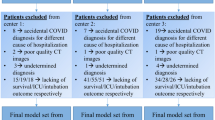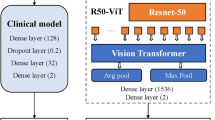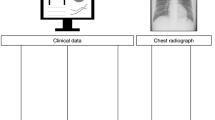Abstract
Objectives
To use deep learning of serial portable chest X-ray (pCXR) and clinical variables to predict mortality and duration on invasive mechanical ventilation (IMV) for Coronavirus disease 2019 (COVID-19) patients.
Methods
This is a retrospective study. Serial pCXR and serial clinical variables were analyzed for data from day 1, day 5, day 1–3, day 3–5, or day 1–5 on IMV (110 IMV survivors and 76 IMV non-survivors). The outcome variables were duration on IMV and mortality. With fivefold cross-validation, the performance of the proposed deep learning system was evaluated by receiver operating characteristic (ROC) analysis and correlation analysis.
Results
Predictive models using 5-consecutive-day data outperformed those using 3-consecutive-day and 1-day data. Prediction using data closer to the outcome was generally better (i.e., day 5 data performed better than day 1 data, and day 3–5 data performed better than day 1–3 data). Prediction performance was generally better for the combined pCXR and non-imaging clinical data than either alone. The combined pCXR and non-imaging data of 5 consecutive days predicted mortality with an accuracy of 85 ± 3.5% (95% confidence interval (CI)) and an area under the curve (AUC) of 0.87 ± 0.05 (95% CI) and predicted the duration needed to be on IMV to within 2.56 ± 0.21 (95% CI) days on the validation dataset.
Conclusions
Deep learning of longitudinal pCXR and clinical data have the potential to accurately predict mortality and duration on IMV in COVID-19 patients. Longitudinal pCXR could have prognostic value if these findings can be validated in a large, multi-institutional cohort.
Similar content being viewed by others
Introduction
Since the first coronavirus disease 2019 (COVID-19) case was reported in December 2019 [1, 2], 500 million people have been infected and more than 6 million people have died worldwide (Jun, 2022) [3]. The role of chest imaging in the diagnosis, prognosis and treatment of this infectious disease has evolved over the course of the COVID-19 pandemic. During the initial outbreak in China when virus assays were unreliable, computed tomography (CT) of the lung was the primary diagnostic tool used for triage and diagnosis [4,5, The datasets generated and analyzed during the current study are available from the corresponding author on reasonable request. Alanine aminotransferase Aspartate aminotransferase Area under the ROC curve Brain natriuretic peptide Class activation map Confidence interval Convolutional neural network Coronavirus disease 2019 C-reactive protein Computed tomography Emergency department Invasive mechanical ventilation Interquartile ranges Lactate dehydrogenase Long-short time memory Mean absolute error Machine learning Portable chest X-ray Rectified linear unit Root mean squared error Receiver operating characteristic Real-time polymerase chain reaction Severe acute respiratory syndrome coronavirus 2 Pulse oxygen saturation White blood cell Zhu N, Zhang D, Wang W, Li X, Yang B, Song J, et al. A novel coronavirus from patients with pneumonia in China, 2019. N Engl J Med. 2020;382(8):727–33. Huang C, Wang Y, Li X, Ren L, Zhao J, Hu Y, et al. Clinical features of patients infected with 2019 novel coronavirus in Wuhan. China Lancet. 2020;395(10223):497–506. https://coronavirus.jhu.edu/map.html. Johns Hopkin University. Ai T, Yang Z, Hou H, Zhan C, Chen C, Lv W, et al. Correlation of Chest CT and RT-PCR Testing in Coronavirus Disease 2019 (COVID-19) in China: A Report of 1014 Cases. Radiology. 2020;296:E32–40. Bernheim A, Mei X, Huang M, Yang Y, Fayad ZA, Zhang N, et al. Chest CT Findings in Coronavirus Disease-19 (COVID-19): Relationship to Duration of Infection. Radiology. 2020;295:691–785. Fang Y, Zhang H, **e J, Lin M, Ying L, Pang P, et al. Sensitivity of Chest CT for COVID-19: Comparison to RT-PCR. Radiology. 2020;296(2):E115–7. Pan F, Ye T, Sun P, Gui S, Liang B, Li L, et al. Time Course of Lung Changes at Chest CT during recovery from coronavirus disease 2019 (COVID-19). Radiology. 2020;925:715–21. Jacobi A, Chung M, Bernheim A, Eber C. Portable chest X-ray in coronavirus disease-19 (COVID-19): a pictorial review. Clin Imaging. 2020;64:35–42. Kim HW, Capaccione KM, Li G, Luk L, Widemon RS, Rahman O, et al. The role of initial chest X-ray in triaging patients with suspected COVID-19 during the pandemic. Emerg Radiol. 2020;27(6):617–21. Schiaffino S, Tritella S, Cozzi A, Carriero S, Blandi L, Ferraris L, et al. Diagnostic performance of chest X-Ray for COVID-19 pneumonia during the SARS-CoV-2 pandemic in Lombardy. Italy J Thorac Imaging. 2020;35(4):W105–6. Wong HYF, Lam HYS, Fong AH, Leung ST, Chin TW, Lo CSY, et al. Frequency and distribution of chest radiographic findings in patients positive for COVID-19. Radiology. 2020;296(2):E72–8. Wong HYF, Lam HYS, Fong AH, Leung ST, Chin TW, Lo CSY, et al. Frequency and distribution of chest radiographic findings in covid-19 Positive Patients. Radiology. 2019;56:201160. Richardson S, Hirsch JS, Narasimhan M, Crawford JM, McGinn T, Davidson KW, et al. Presenting characteristics, comorbidities, and outcomes among 5700 patients hospitalized with COVID-19 in the New York City area. JAMA. 2020;323(20):2052–9. Ende VJ, Singh G, Babatsikos I, Hou W, Li H, Thode HC, et al. Survival of COVID-19 patients with respiratory failure is related to temporal changes in gas exchange and mechanical ventilation. J Intensive Care Med. 2021;36(10):1209–16. Ranney ML, Griffeth V, Jha AK. Critical supply shortages - the need for ventilators and personal protective equipment during the covid-19 pandemic. N Engl J Med. 2020;382(18): e41. Deo RC. Machine Learning in Medicine. Circulation. 2015;132(20):1920–30. Santos MK, Ferreira Junior JR, Wada DT, Tenorio APM, Barbosa MHN, Marques PMA. Artificial intelligence, machine learning, computer-aided diagnosis, and radiomics: advances in imaging towards to precision medicine. Radiol Bras. 2019;52(6):387–96. Tschandl P, Codella N, Akay BN, Argenziano G, Braun RP, Cabo H, et al. Comparison of the accuracy of human readers versus machine-learning algorithms for pigmented skin lesion classification: an open, web-based, international, diagnostic study. Lancet Oncol. 2019;20(7):938–47. Alaa AM, Bolton T, Di Angelantonio E, Rudd JHF, van der Schaar M. Cardiovascular disease risk prediction using automated machine learning: A prospective study of 423,604 UK Biobank participants. PLoS ONE. 2019;14(5): e0213653. Harris M, Qi A, Jeagal L, Torabi N, Menzies D, Korobitsyn A, et al. A systematic review of the diagnostic accuracy of artificial intelligence-based computer programs to analyze chest X-rays for pulmonary tuberculosis. PLoS ONE. 2019;14(9): e0221339. Bae J, Kapse S, Singh G, Phatak T, Green J, Madan N, et al. Predicting Mechanical Ventilation Requirement and Mortality in COVID-19 using Radiomics and Deep Learning on Chest Radiographs: A Multi-Institutional Study. Ar**v. 2020. Kim HW, Capaccione KM, Li G, Luk L, Widemon RS, Rahman O, et al. The role of initial chest X-ray in triaging patients with suspected COVID-19 during the pandemic. Emerg Radiol. 2020;89:1–5. Toussie D, Voutsinas N, Finkelstein M, Cedillo MA, Manna S, Maron SZ, et al. Clinical and Chest radiography features determine patient outcomes in young and middle age adults with COVID-19. Radiology. 2020;297(1):E197–206. Cozzi D, Albanesi M, Cavigli E, Moroni C, Bindi A, Luvara S, et al. Chest X-ray in new Coronavirus Disease 2019 (COVID-19) infection: findings and correlation with clinical outcome. Radiol Med. 2020;125(8):730–7. Cohen JP, Dao L, Roth K, Morrison P, Bengio Y, Abbasi AF, et al. Predicting COVID-19 pneumonia severity on chest X-ray with deep learning. Cureus. 2020;12(7): e9448. Zhu J, Shen B, Abbasi A, Hoshmand-Kochi M, Li H, Duong TQ. Deep transfer learning artificial intelligence accurately stages COVID-19 lung disease severity on portable chest radiographs. PLoS ONE. 2020;15(7): e0236621. Kikkisetti S, Zhu J, Shen B, Li H, Duong TQ. Deep-learning convolutional neural networks with transfer learning accurately classify COVID-19 lung infection on portable chest radiographs. PeerJ. 2020;8: e10309. Hussain L, Nguyen T, Li H, Abbasi AA, Lone KJ, Zhao Z, et al. Machine-learning classification of texture features of portable chest X-ray accurately classifies COVID-19 lung infection. Biomed Eng Online. 2020;19(1):88. Zhao Z, Chen A, Hou W, Graham JM, Li H, Richman PS, et al. Prediction model and risk scores of ICU admission and mortality in COVID-19. PLoS ONE. 2020;15(7): e0236618. Lam KW, Chow KW, Vo J, Hou W, Li H, Richman PS, et al. Continued in-hospital ACE inhibitor and ARB Use in hypertensive COVID-19 patients is associated with positive clinical outcomes. J Infect Dis. 2020;222(8):1256–64. Zhang P, Zhu L, Cai J, Lei F, Qin JJ, **e J, et al. Association of inpatient use of angiotensin converting enzyme inhibitors and angiotensin II receptor blockers with mortality among patients with hypertension hospitalized with COVID-19. Circ Res. 2020;26:1671–81. Jiang X, Coffee M, Bari A, Wang J, Jiang X, Huang J, et al. Towards an artificial intelligence framework for data-driven prediction of coronavirus clinical severity. Comput Mater Continua. 2020;63:537–51. **e J, Daniel H, Hui C, Simon TA, Shusheng L, Guozheng W, et al. development and external validation of a prognostic multivariable model on admission for hospitalized patients with covid-19. medRxiv. 2020. Ji D, Zhang D, Xu J, Chen Z, Yang T, Zhao P, et al. Prediction for progression risk in patients with COVID-19 Pneumonia: the CALL Score. Clin Infect Dis. 2020;71:1393–9. Hu H, Yao N, Qiu Y. Comparing rapid scoring systems in mortality prediction of critically ill patients with novel coronavirus disease. Acad Emerg Med. 2020;78:619. Li Q, Guan X, Wu P, Wang X, Zhou L, Tong Y, et al. Early Transmission Dynamics in Wuhan, China, of Novel Coronavirus-Infected Pneumonia. N Engl J Med. 2020;382(13):1199–207. Zhu JS, Ge P, Jiang C, Zhang Y, Li X, Zhao Z, et al. Deep-learning artificial intelligence analysis of clinical variables predicts mortality in COVID-19 patients. J Am Coll Emerg Physicians Open. 2020;1:1364–73. Chen A, Zhao Z, Hou W, Singer AJ, Li H, Duong TQ. Time-to-Death longitudinal characterization of clinical variables and longitudinal prediction of mortality in COVID-19 patients: a two-center study. Front Med (Lausanne). 2021;8: 661940. Hou W, Zhao Z, Chen A, Li H, Duong TQ. Machining learning predicts the need for escalated care and mortality in COVID-19 patients from clinical variables. Int J Med Sci. 2021;18(8):1739–45. Li X, Ge P, Zhu J, Li H, Graham J, Singer A, et al. Deep learning prediction of likelihood of ICU admission and mortality in COVID-19 patients using clinical variables. PeerJ. 2020;8: e10337. Lu JQ, Musheyev B, Peng Q, Duong TQ. Neural network analysis of clinical variables predicts escalated care in COVID-19 patients: a retrospective study. PeerJ. 2021;9: e11205. Shen B, et al. Initial chest radiograph scores inform COVID-19 status, intensive care unit admission and need for mechanical ventilation. Clin Radiol. 2021;76(6):473.e1–7. Simonyan K, A. Z. Very Deep Convolutional Networks for Large-Scale Image Recognition. ar**v:14091556. 2014. Shelhamer E, Long J, Darrell T. Fully Convolutional Networks for Semantic Segmentation. IEEE Trans Pattern Anal Mach Intell. 2017;39(4):640–51. Hochreiter S. Schmidhuber JJNc. Long short-term memory. 1997;9(8):1735–80. None. None. TR and HD collected, curated, and processed data, created the algorithms and models, debugged and trained models, analyzed data, interpreted results, and drafted the manuscript. TQD supervised the project and edited the manuscript. All authors reviewed and modified the manuscript. This study was Institutional Review Board approved and a waiver of consent was obtained. All authors have given consent for publication. The authors have no conflicts of interest to declare. Springer Nature remains neutral with regard to jurisdictional claims in published maps and institutional affiliations. Open Access This article is licensed under a Creative Commons Attribution 4.0 International License, which permits use, sharing, adaptation, distribution and reproduction in any medium or format, as long as you give appropriate credit to the original author(s) and the source, provide a link to the Creative Commons licence, and indicate if changes were made. The images or other third party material in this article are included in the article's Creative Commons licence, unless indicated otherwise in a credit line to the material. If material is not included in the article's Creative Commons licence and your intended use is not permitted by statutory regulation or exceeds the permitted use, you will need to obtain permission directly from the copyright holder. To view a copy of this licence, visit http://creativecommons.org/licenses/by/4.0/. The Creative Commons Public Domain Dedication waiver (http://creativecommons.org/publicdomain/zero/1.0/) applies to the data made available in this article, unless otherwise stated in a credit line to the data. Duanmu, H., Ren, T., Li, H. et al. Deep learning of longitudinal chest X-ray and clinical variables predicts duration on ventilator and mortality in COVID-19 patients.
BioMed Eng OnLine 21, 77 (2022). https://doi.org/10.1186/s12938-022-01045-z Received: Accepted: Published: DOI: https://doi.org/10.1186/s12938-022-01045-zAvailability of data and materials
Abbreviations
References
Acknowledgements
Funding
Author information
Authors and Affiliations
Contributions
Corresponding author
Ethics declarations
Ethics approval and consent to participate
Consent for publication
Competing interests
Additional information
Publisher's Note
Rights and permissions
About this article
Cite this article
Keywords




